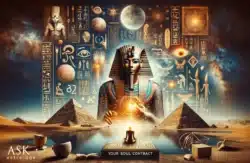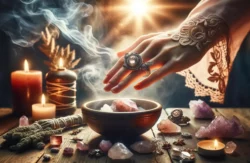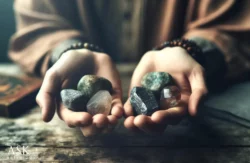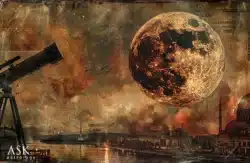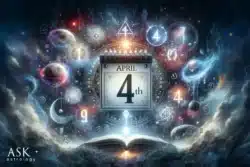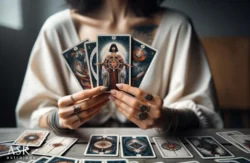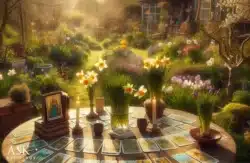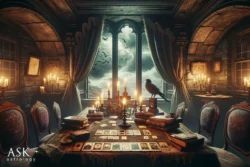The relationship of the Sun and Moon is at the very heart of astrology since astrology reflects the essence of life. The Sun relates to our daylight hours and the Moon to night time, whereby we experience light and dark in the natural world. The Sun and Moon are together traditionally referred to as the “Lights” in astrology – daylight and night light. Although night light can be dark, with the Moon our path is often still lit to some extent. Differentiation in the amount of light depends on where we are in each monthly cycle. There is a correlation between nature symbolism and human reality, which astrology recognizes. As such, the position of the Moon in relation to the Sun therefore also reflects how much access we have to our range of conscious and unconscious awareness at any given moment.
The Role of the Moon
The Moon can be seen to shine light on the parts of the psyche that are usually more hidden. When there is more of the Moon’s light showing, we may understand more about our inner self – our deeper motivations, mechanisms, and feelings. These often relate to the more instinctive thoughts and behaviors, that make us tick without really knowing why. We don’t so much think about how to act; it becomes automatic behavior based on senses and simple needs. It may not be so easy to judge such behavior as right or wrong, in any larger context. But we might recognize it as instinctive or habitual. This underground, Moon type of behavior can be good news when it comes to actions that we don’t need to have to think about, but which do need to happen.
The Moon’s cycles are on the automatic waveband most of the time, letting us act in a sort of personal auto-pilot mode. We can see them as reflecting the autonomic nervous system in humans, where basic actions like the actions of breathing and the heart beating just keep ticking over, under normal circumstances. Something similar can be said of the hormonal exchanges that go on between the brain and the body. But – crucially – in our natural world, without the Sun the Moon’s light would not exist. The Moon has no light of its own and simply reflects the Sun’s light. Again, it depends where we are in the month as to how much light is cast and seen.
The Role of the Sun
Looking at the role of the Sun, in traditional astrology, it is linked with clarity and rationale. This is rather different from the Moon’s connection with instinct and automatic behavior – although both might be said to have an internal sense of order. Either way, we can see the Sun and Moon as working together, in various ways. In astrology, there is a particular set of meanings through how they co-exist, in their spatial relations, which are measured by geometric angles. Although that may sound complicated, in more simple terms, we can appreciate that the how the Sun and Moon are located in relation to one another will tell us how much light is around in our universe at any one time. In astrology, this is made extra interesting, by noting in which zodiac signs the Sun and Moon are located – and thinking about whether or those signs have a rapport, or are in some sort of conflict. In this way, we can consider how easy it is for the Sun and Moon to co-exist – whether one is happy that the other is around, or if it is frequently trying to take up more of the space!
At the extreme end, the Moon may seem to block the light of the Sun, or vice versa – which is most obvious in the phenomena of eclipses. Eclipses are not frequent occurrences through the months of the year – they usually only happen during two time periods, in winter and summer. They are therefore fairly unusual formations, within the larger pattern of new and full Moon phases that occur like clockwork, every month.
The New Moon
The new Moon occurs when the Sun and Moon are roughly in the same spot, but with neither completely blocking the other’s light. Astrologers call this meeting of planets a conjunction – they are effectively ‘conjoined’ – as a close-knit team. Action tends to be intense and focussed with Sun-Moon conjunction, as though the team’s eyes are on the same goal. Astrologically, we might see it that the logic and clarity of the Sun is in harmony with the instincts and intuition of the Moon. There is good teamwork between these sets of faculties!
The Full Moon
When there is a full Moon, this means that the Sun and Moon are at opposite points in the sky, like two people seeing one another from opposite ends of a room. We can liken this to other polar opposites in the universe – like the North and South Poles, where the points are as far away from each other as it is possible to be. Metaphorically, this is like saying that the Sun and Moon do not see eye to eye. So, we may find we feel more conflicted when there’s a full Moon. We may experience people around us opposing our ideas, or we may simply struggle to understand the way others think and act. Sometimes we just feel alone and different. But it can also be that we experience the opposing poles of the Sun and Moon as feeling pulled in quite different directions. And sometimes it is about imbalance, such as just having too much on our plate, making it very full time, so we feel quite overwhelmed and easily knocked off balance. Or it is like being on a see-saw, where we are bobbing up and down emotionally, with things seeming logical and calm one moment, and suddenly up in the air and chaotic the next.
The Waxing and Waning Phases
The new and full Moon periods can be seen to present start and finish points on the cycle of the Moon around the Earth. The movement from New to Full Moon is the waxing part of the cycle – that is, when energy is building up. This energy can emerge in various ways, such as emotional intensity, physical oomph or a clearer, creative vision. Once Full Moon – the opposition of the Moon to the Sun – has been reached – the Moon goes through its waning phases, as its light appears to decrease and it looks thinner, as it travels on to the next New Moon. This collection of waxing and waning phases is sometimes shown in a circular fashion as the face of a clock, which reminds us that these spatial differences occur across a cycle of time.
We can see the New Moon (or Sun-Moon conjunction moment) as a time when ideas and situations are very new. They may be in seedling form, not yet fully formed. These are like our fleeting or half-baked ideas – plans that might or might not take shape in the future. We will nurture them or not, depending on what else happens, and what seems important to us, with priorities sometimes changing across the cycle. The Full Moon usually corresponds with the other end of the scale, where plans and situations have then become full of life and shape, or may even seem larger than life, almost! We may feel over-loaded and could need to make some adjustments, to regain a sense of balance.
The Half Moons
In between the phases of the New and Full Moons are the half Moons (maybe confusingly sometimes referred to as the ‘Quarter’ Moons) – and other significant relationships of the Sun and Moon in space and time. Half Moons occur when the Sun and Moon are located at 90 degrees apart from one another – if we think of them located around a circle, which is divided into four sections through two lines crossing North to South and East to West, we can imagine them at right-angles to each other. What we see from our viewpoint of them on Earth, however, looks like a half of the Moon is lit up.
Dane Rudhyar, author of The Lunation Cycle, one of the most detailed astrology books on lunar phases (as the Moon’s orbit of the earth and relationship to the Sun are also known) described the half Moon times as representing critical moments, or turning points. We may suddenly realize that, if our plans that we thought about on the New Moon are really going to go anywhere, we may have to put in more effort. The half Moon following that new Moon gives us a sense of urgency, or motivation and energy, to take action. After the full Moon, when life has become very hectic, usually, we will experience another half Moon, about a week onward. At that time we may realize that we need to reduce the pressure on ourselves and restore our lives to greater equilibrium. Alternatively, we may have to pedal even faster and work even harder to finish something that remains only part-completed. Either way, we will usually know what needs to be done around those half Moons! This may be instinctual, or, since the Moon relates to memories, we remember something vital that we feel moved to act on. Or life sends us a message in some other way, making it clear that action is needed.
The Connection Between the Sun and Moon
This cycle of the Moon’s phases – which shows the measure of light between the Sun and the Moon – is something we can follow month by month and week by week, through the year. We can watch plans develop and unfold and then see chapters closing and others starting to open.
We can also see the relevance of the Sun-Moon relationship in the birth charts, by noting the closest lunar phase represented by that connection. If we were born close to a Full Moon, with Sun and Moon in opposite signs, we may often be intent on completing something important. Completion will become a very central, motivating theme to us, in all sorts of ways. If born closer to a new Moon, our being able to experience some new starts may be vital to us. Nearer to a half Moon, perhaps we quite often experience a sense of crisis, or internal conflict between our instincts and the ‘right’ thing to do, especially according to how we imagine others will judge us.
There are other significant stages of the relationship between the Sun and Moon in between those already mentioned, known as the crescent, gibbous, disseminating and balsamic phases of the Moon. They are each associated with particular degree spans within the waxing and waning hemicycles of the Moon. Their significance can seem more important in individual birth charts – that is, in the birth pattern relationship of the Sun and Moon, which can be seen to show something unique about us as people. This may be especially so when taken together with the placements of the overall planets in the birth chart. We could call it our ‘soli-lunar signature’, reflecting something about our internal makeup and the way we process information. Or how we experience life happening around us – as well as how we respond to it.
It’s All About the Light
Whatever the context for looking at the Sun and Moon may be, it remains useful to remember that it’s all about the light with the Sun-Moon relationship – and about how much we can see or may want to see, at any given time. This includes how we understand ourselves, as well as the other people we come across and are involved with. It can be interesting to look at the Sun-Moon connections between sets of charts, too. In a close relationship, we can start to think about how our Sun sign interacts not just with another person’s Sun sign, but also with their Moon sign. Looking for the relationships of light and shade is endlessly fascinating in astrology!





























